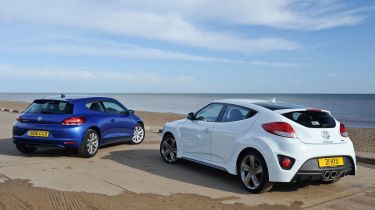Hyundai Veloster Turbo vs Volkswagen Scirocco
How will the Hyundai fare against the benchmark sporty coupe?
Combining smart coupe looks and hatchback practicality has proven a great success for Hyundai, and we were hugely impressed with the Veloster on its test debut.
Our only criticism was of the gutless and uninspiring engine, which has now been addressed with the arrival of this sportier turbocharged version. However, upping the power output has also significantly increased the price – and placed the Veloster squarely in the sights of a long-running Auto Express favourite: the Volkswagen Scirocco.
The Veloster has had a cosmetic overhaul to go with its power hike. The gaping grille, angled LED running lights and central twin exhausts ensure it will draw plenty of glances on the road. Yet when the two are lined up together, the older Volkswagen looks more striking. A low nose and sharply rising shoulder line give a squat, purposeful stance, and its curving design is easier on the eye than the angular Veloster. Buyers will have to make up their own minds, but both do enough to stand out in a market crowded with handsome coupes.
Climb aboard the Hyundai and some switches are recognisable from the company’s other models. Plus, some of the hard plastics used aren’t up to the standards of its new i30 hatch. Still, there’s lots of standard kit. Everything from the embossed and heated leather seats to the climate control and reversing camera is included for £21,995.
Used - available now

2019 Ford
Fiesta Vignale
44,100 milesManualPetrol1.0L
Cash £10,500
2022 Volkswagen
ID.3
33,043 milesAutomaticElectric
Cash £13,500
2023 Audi
e-tron
50,934 milesAutomaticElectric
Cash £18,900
2022 Dacia
Duster
49,300 milesManualPetrol1.0L
Cash £11,100Gadgets like this are optional on the entry-level Scirocco, but VW does make up for this lack of equipment with high-class materials and a superb level of fit and finish. It all feels much classier than the Hyundai, while the nicely positioned seats and clearly marked layout make it easy to find key functions. This basic model could do with some excitement – such as the alloy pedals in its rival – but the cabin has a solidity that the Veloster’s lacks.
This is most obvious in the Hyundai on the thick grab handles inside the doors and the thin-rimmed multifunction steering wheel, which should feel nicer considering this is the performance flagship of the range.
However, the Veloster has a practical trick up its sleeve. Its novel 2+1 asymmetric doors allow easier access to the rear than in the Scirocco – even if you have to slide across the seat to sit behind the driver. Some cynics will write this feature off as just a gimmicky marketing ploy, but anyone used to regularly fitting child seats or carrying more than one passenger in the back will find it useful.
So it’s a shame that space is so tight once you’re sitting in the back of the Hyundai. Even those of average height will feel their heads brushing the glass tailgate, and the individual seats lack the support you get in the VW.
Putting these niggles aside will be easy if the Veloster can make a good impression on the road. With an extra 26bhp and 33kg less weight, it feels faster than the 158bhp, 1,346kg Scirocco and surges along with an urgency missing from the standard car. The steering’s been tweaked to improve feel and the dampers stiffened for flatter cornering, but while the Turbo handles tidily, it can’t match the dynamic precision of its rival. The VW has sharper brakes and more accurate steering that gives you the confidence to push harder in corners.
During normal driving, the Scirocco is more refined, with less wind and tyre noise. So while the manic Hyundai will be faster on a winding B-road, the VW is more suited to everyday use and is just as rewarding to drive.
Factor in typically high residual values, plus fixed-price servicing, and the Veloster becomes harder to justify at this price. Even with a five-year, unlimited-mileage warranty, it really has its work cut out to win this half of the test.







